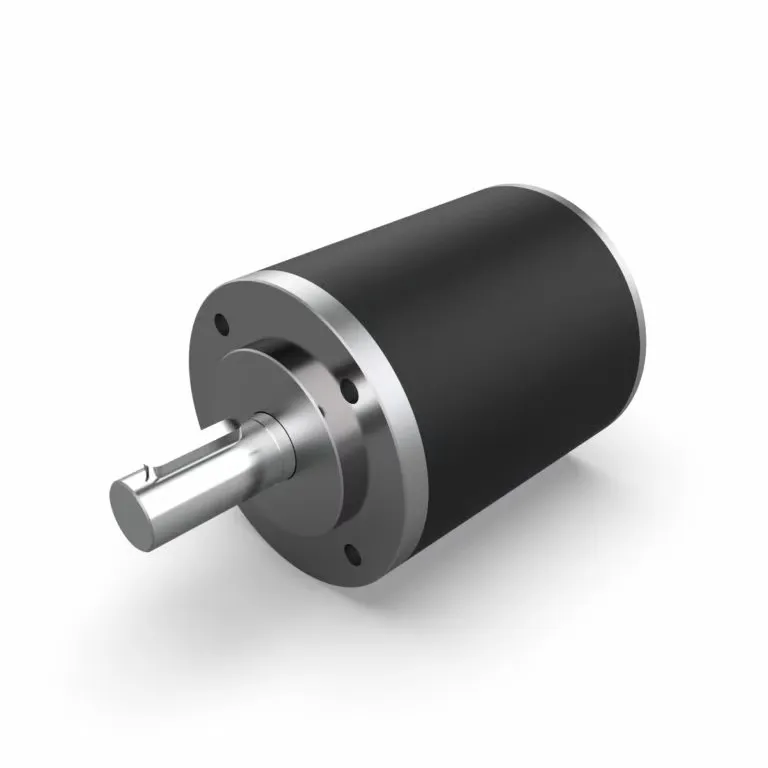ဘရပ်လျင်းမဟုတ်သော DC အက်ချင်း၏ အဓိကဆိုင်ရာ အမြတ်အထွေထွေများ
အလွန်အားကြီး သို့မဟုတ် တိုက်ရိုက်မှုထွက်ထွက်
ပါဝါနှင့် အလေးချိန် အချိုးအစားအရ မော်တာများကို ကိုင်တွယ်ရာတွင် BLDC မော်တာများသည် အကောင်းဆုံးအခြေအနေဖြစ်ပြီး တူညီသောနေရာကိုသာ ယူထားသော်လည်း ပုံမှန်မော်တာများနှင့် နှိုင်းယှဉ်ပါက တိုက်ကျော်တန်ခိုးပိုမိုထုတ်လုပ်နိုင်သည်။ ထို့ကြောင့် နေရာစုပ်ယူမှုကို အလေးအနက်ထားရသည့် နယ်ပယ်များတွင် အသုံးပြုရန် အကောင်းဆုံးဖြစ်သော အဖြေများအဖြစ် ပြောင်းလဲလာနေပါသည်။ ဥပမာအားဖြင့် ရိုဘော့စ် သို့မဟုတ် လေယာဉ်အင်ဂျင်နီယာပညာရပ်များကို စဉ်းစားပါ။ အလေးချိန်ပေါပေါဖြစ်ရပြီး တိုက်ကျော်တန်ခိုးရှိသည့် အရာများကို ဒီဇိုင်းထုတ်သည့်အခါတွင် ထပ်တိုးဂရမ်များက အားလုံးကိုပြောင်းလဲနိုင်သည်။ BLDC မော်တာများသည် သေးငယ်သော ပက်ကေ့ချ်များတွင် တိုက်ကျော်တန်ခိုးကို ထုတ်လုပ်ပေးသည်။ နောက်ထပ်တစ်ခုမှာ ဤမော်တာများသည် တိုက်ကျော်တန်ခိုးကို မည်ကဲ့သို့ ချောမွေ့စွာ ပေးဆောင်သည်ကို ဖော်ပြသည့်အချက်ဖြစ်သည်။ လုပ်ဆောင်မှုအတွင်းတွင် တုန့်ပြန်မှုမှာ ချိန်ညှိမှုနည်းပါးပြီး ချက်ချင်းတုန့်ပြန်မှုဖြစ်သည်။ ထိုကဲ့သို့သော တုန့်ပြန်မှုသည် တိကျသောရွှေ့ပြောင်းမှုများကို လိုအပ်သည့် အသုံးချမှုများတွင် အလွန်ကောင်းမွန်သည်။ ဥပမာအားဖြင့် စက်မှုထုတ်လုပ်မှုလိုင်းများ သို့မဟုတ် တည်ငြိမ်မှုနှင့် တုန့်ပြန်မှုအချိန်များကို မဖြစ်မနေလိုအပ်သည့် ဆေးဘက်ဆိုင်ရာကိရိယာများကို ပြောရမည်ဆိုပါက။
အင်အားသုံးစွဲမှုနှင့် လုပ်ဆောင်ချိန်
BLDC မော်တာများသည် စွမ်းအင်ထိရောက်ရှိမှုအရ ထင်ရှားပြီး မကြာခဏ ၉၀% ထက်ကျော်သော ထိရောက်ရှိမှုကို ရရှိနိုင်ပါသည်။ လအတန်ကြာ လည်ပတ်မှုအပြီးတွင် ဤကဲ့သို့သော စွမ်းဆောင်ရည်မျိုးသည် အီလက်ထရစ်ဘီလျောင်းများတွင် ငွေကုန်ကျစရိတ်များ ခြွေတာနိုင်မှုကို ဖော်ပြပါသည်။ ထို့ကြောင့် ထုတ်လုပ်ရေးနှင့် အလိုအလျောက်လုပ်ဆောင်ရေး လုပ်ငန်းခွင်များတွင် အများအပြားသော ကုမ္ပဏီများသည် အစွန်းရောင်စွမ်းဆောင်ရည်အတွက် ဤမော်တာများကို အသုံးပြုလာကြပါသည်။ BLDC မော်တာများသည် အဘယ်ကြောင့် ခံနိုင်ရည်ရှိသနည်း။ အကြောင်းမှာ ၎င်းတို့တွင် အချိန်ကြာလာသည်နှင့်အမျှ အသုံးပြုနေသော ပုံမှန်ဘရပ်ရှ်များ မပါဝင်ပါ။ မော်တာအိုင်းတွင် ဘရပ်ရှ်များကြောင့် ပွတ်တိုက်မှုဖြစ်ပေါ်မှု မရှိတော့သောကြောင့် လည်ပတ်စဉ်ကာလအတွင်း စက်မှုစိတ်ဖိစီးမှုများ နည်းပါးလာပါသည်။ ရလဒ်အနေဖြင့် အစိတ်အပိုင်းများ ပျက်စီးမှုနည်းပါးခြင်းကြောင့် ပုံမှန်ဘရပ်ရှ်များနှင့် နှိုင်းယှဉ်ပါက ပြုပြင်ထိန်းသိမ်းမှုအကြိမ်ရေ အတန်ကြာ ကြာမြင့်စေပါသည်။ ၂၄ နာရီပတ်လုံး လည်ပတ်နေသော စက်ရုံများအတွက် စွမ်းအင်စားသုံးမှုနည်းပါးမှုနှင့် အနားယူမှုအနည်းငယ်ရှိမှုတို့၏ ဤပေါင်းစပ်မှုကြောင့် ထုတ်လုပ်မှုစက်ဝန်းများစွာအတွက် အမြတ်အစွန်းကို တိုးတက်စေပါသည်။
အသေးစိတ်ဖြင့် အလုပ်လုပ်သည့် မျဉ်းချောင်းမှု
BLDC မော်တာများသည် အလွန်တိတ်ဆိတ်စွာ လည်ပတ်နေသောကြောင့်၊ ၎င်းတို့သည် ဆေးရုံများနှင့် သုတေသနဓာတ်ခွဲခန်းကဲ့သို့သော နေရာများတွင် အလွန်အရေးပါသော ဆူညံသံအနည်းငယ်မျှပင် သိမ်မွေ့သောအလုပ်ကို အနှောင့်အယှက်ဖြစ်စေနိုင်သည်။ အဆိုပါ သမားရိုးကျ ကာဗွန်စုတ်တံများသည် ပွတ်တိုက်မှုကို မဖန်တီးဘဲ၊ အဆိုပါ မော်တာများသည် လျှပ်စစ်သံလိုက် စွက်ဖက်မှုကို လျှော့ချပေးကာ စက်ပိုင်းဆိုင်ရာ ဆူညံသံများ လျော့နည်းစေသည်။ ဆေးဘက်ဆိုင်ရာပစ္စည်းများ သို့မဟုတ် စက်မှုအလိုအလျောက်စနစ်များကဲ့သို့ တိကျမှုအရှိဆုံးအရာများအတွက် ၎င်းတို့ကို ပြီးပြည့်စုံစေသည်။ ဆူညံသံအဆင့်နိမ့်သည် အနီးနားရှိ အရေးကြီးသော အီလက်ထရွန်နစ်ပစ္စည်းများကို အနှောင့်အယှက်မဖြစ်စေဘဲ တိုင်းတာမှုများ တိကျစေပြီး ပြင်ပအချက်များမှ မမျှော်လင့်ထားသော အနှောက်အယှက်များမရှိဘဲ လည်ပတ်မှုများကို ချောမွေ့စွာလည်ပတ်စေပါသည်။
ပြောင်းလဲနိုင်သော အလျှော်မာန်ကို အားကစားရန်အတွက် အလက်ထောက်ကန့်သတ်
BLDC မော်တာများသည် ခေတ်မှီ အီလက်ထရွန်းနစ် ထိန်းချုပ်မှုများနှင့် အတူတူတိုင်း ကောင်းစွာလုပ်ဆောင်ပေးသည့်အတွက် မော်တာ၏ အမြန်နှုန်းကို တိကျစွာ ထိန်းညှိရာတွင် အထူးသင့်လျော်ပါသည်။ အမြန်နှုန်းကို တိကျစွာ ထိန်းညှိနိုင်မှုသည် ထိန်းချုပ်မှုတိကျမှု လိုအပ်သည့်နေရာများတွင် အထူးအသုံးဝင်ပါသည်။ ဥပမာ- ထုတ်လုပ်ရေးလိုင်းတွင် ဖြစ်ပွားမှုများပေါ်မူတည်၍ အမြန်နှုန်း လျော့နည်းသွားခြင်း သို့မဟုတ် တိုးလာခြင်းတို့ကို လိုအပ်သည့် စက်ရုံများရှိ ကွန်ဗဲလ်ဘဲလ်များကို စဉ်းစားပါ။ ဤမော်တာများကို ထူးခြားစေသည့်အချက်မှာ ၎င်းတို့သည် နှေးကွေးစွာ လည်ပတ်နေသည့်အချိန် သို့မဟုတ် အပြည့်အဝ အမြန်နှုန်းဖြင့် လည်ပတ်နေသည့်အချိန်တွင် တွင် စွမ်းအင်ထုတ်လုပ်မှုကို တောင့်တင်းစွာ ထိန်းသိမ်းထားနိုင်ခြင်းဖြစ်ပါသည်။ RPM အဆင့်အားလုံးတွင် ဤသို့စွမ်းဆောင်ရည်များ ပြသနေသည့်အတွက်ကြောင့် BLDC မော်တာများကို စက်ရုံကြီးများရှိ စက်ပစ္စည်းများမှသည် နေအိမ် သို့မဟုတ် ရုံးတွင် နေ့စဉ်အသုံးပြုသည့် သေးငယ်သော ကိရိယာများအထိ တွင် တွေ့ရှိနိုင်ပါသည်။
လှုပ်ရှားမှု လျော့နည်းခြင်း
BLDC မော်တာဒီဇိုင်းများသည် အခြားမော်တာများနှင့် နှိုင်းယှဉ်ပါက ထိန်းသိမ်းရန်လိုအပ်သည့်အလုပ်ပမာဏကို သိသာစွာလျော့နည်းစေပါသည်။ ဤမော်တာများတွင် ဘရပ်ရှ်များအမှန်အကန် မပါဝင်သောကြောင့် အစိတ်အပိုင်းများ သုံးစွဲမှုကြောင့် ထိခိုက်ပျက်စီးမှုများ နည်းပါးစေပါသည်။ ထို့ကြောင့် မော်တာအသက်အရွယ်အတွင်း ပျက်စီးမှုနည်းပါးပြီး ထိန်းသိမ်းရန်စရိတ်ကို သက်သာစေပါသည်။ စက်ရုံများနှင့် ထုတ်လုပ်ရေးအလုပ်ရုံများတွင် မော်တာရပ်နားမှုကြောင့် ငွေကြေးဆုံးရှုံးမှုများကို ကာကွယ်ရန်အတွက် ဤအချက်သည် နေ့စဉ်လည်ပတ်မှုများကို အဆင်ပြေစေရန် အမှန်အကန်ကူညီပေးပါသည်။ မော်တာ၏သက်တမ်းနှင့် ထိန်းသိမ်းမှုလိုအပ်မှုကို စုစည်း၍ကြည့်ပါက စုစုပေါင်းစရိတ်သည် ပုံမှန်ဘရပ်ရှ်မော်တာများထက် သိသာစွာနည်းပါးပါသည်။ အများစုကုမ္ပဏီများအတွက် BLDC နည်းပညာသို့ ပြောင်းလဲခြင်းသည် ရင်းနှီးမြှုပ်နှံမှုအရ အကျိုးအမြတ်များစွာဖြစ်ပေါ်စေပါသည်။
မိုတာ တီးခြင်းများကြား နှိုင်းယှဉ်ခြင်း
ဆေးပါသော နှင့် ဆေးမပါသော မိုတာ ရှူပါမှု ချိန်များ
ဘရပ်ရှ်မော်တာနှင့် ဘရပ်ရှ်မဟုတ်သော မော်တာများကြားတွင် ထိန်းသိမ်းမှုလိုအပ်ချက်များမှာ မတူညီပါ။ ဘရပ်ရှ်မော်တာများတွင် အချိန်ကြာလာသည်နှင့်အမျှ ပုံမှန်ထိန်းသိမ်းမှုများ လိုအပ်လာပါလိမ့်မည်။ ဥပမာအားဖြင့် အသုံးပြုထားသော ဘရပ်ရှ်များကို အစားထိုးရာတွင် ပိုမိုသော ကြိုးစားအားထုတ်မှုနှင့် ငွေကုန်ကျစရိတ်များကို တွက်ချက်ရပါမည်။ နောက်တစ်ဖက်တွင်မူကား BLDC မော်တာများအတွက် အသက်သာဖြစ်စေမည့် ထိန်းသိမ်းမှုများကို အများအားဖြင့် လုပ်ဆောင်ပေးရန် မလိုအပ်ပါ။ ဘာကြောင့်လဲဆိုတော့ ဘရပ်ရှ်များမရှိခြင်းကြောင့် အစိတ်အပိုင်းများ အသုံးပြုနိုင်သည့်အချိန်ကို လျော့နည်းစေပါသည်။ စက်မှုလုပ်ငန်းများမှ အချက်အလက်များအရ BLDC မော်တာများသည် အခြားမော်တာများနှင့် နှိုင်းယှဉ်ပါက အသက်အားဖြင့် ၁၀ ဆခန့် ကြာရှည်စွာ အသုံးပြုနိုင်သည်ကို တွေ့ရပါသည်။ အမြဲတမ်းပြုပြင်ထိန်းသိမ်းမှုမလိုအပ်သော စက်ပစ္စည်းများကို အသုံးပြုရန်လိုအပ်သည့် လုပ်ငန်းများအတွက် ဤကွာခြားမှုမှာ အရေးပါသော အချက်ဖြစ်ပါသည်။ စက်ရုံများနှင့် ထုတ်လုပ်ရေးစက်မှုလုပ်ငန်းများတွင် ဤမော်တာများကြောင့် ပိုမိုနည်းပါးသော ပြုပြင်ထိန်းသိမ်းမှုကာလနှင့် ပြုပြင်မွမ်းမံရေးစရိတ်များကို ခံစားနိုင်သည်ကို အထူးအားဖြင့် အသိအမှတ်ပြုပါသည်။ ထိန်းသိမ်းမှုစရိတ်များ လျော့နည်းလာခြင်းသည် ငွေကြေးစုဆောင်းမှုကို တိုက်ရိုက်ဖြစ်စေပါသည်။ ဤကြောင့်ပင် စက်မှုလုပ်ငန်းများမှ BLDC နည်းပညာကို ပိုမိုထိရောက်စွာ အသုံးပြုနိုင်ရန်နှင့် ရှည်လျားသောကာလအတွက် စရိတ်ထိန်းချုပ်မှုအတွက် ပြောင်းလဲအသုံးပြုလာကြခြင်းဖြစ်ပါသည်။
AC အစားထိုးများနှင့် နှိုင်းယှဉ်ပြီး မြင့်မားသော RPM ရည်ရွယ်ချက်များ
BLDC မော်တာများသည် အများအားဖြင့် AC မော်တာများကို ကျော်လွန်သော အမြန်နှုန်းဖြင့် လှည့်ပတ်ရာတွင် အမှန်တကယ် ထင်ရှားပါသည်။ အမြန်နှုန်း၏ တိုက်ရိုက်ခုန်တက်မှုများ သို့မဟုတ် တစ်ခုတည်းသော အမြင့်ဆုံးစွမ်းဆောင်ရည်ကို လိုအပ်သော အခြေအနေများတွင် ၎င်းတို့သည် ကောင်းစွာလုပ်ဆောင်ပါသည်။ ယနေ့ခေတ်တွင် လမ်းမကြီးများပေါ်တွင် အဆိုးပြေးနေသော လျှပ်စစ်ကားများ သို့မဟုတ် ကျွန်ုပ်တို့မြင်နေရသော သေးငယ်သော quadcopters များကို မည်ကဲ့သို့ အားပေးသည်ကို စဉ်းစားပါ။ ၎င်းတို့ကို RPM များတွင် ဘာကောင်းစေသနည်း။ အခြားမော်တာအမျိုးအစားများနှင့် နှိုင်းယှဉ်ပါက ၎င်းတို့၏ဒီဇိုင်းသည် စွမ်းအင်ကို နည်းနည်းနှင့် ဖြစ်စေသည်။ ဘက်ထရီဖြင့် လည်ပတ်နေသော အရာများအတွက် အရေးကြီးပါသည်။ နောက်ဆုံးတွင်တော့ တစ်စုံတစ်ခုကို အမှန်တကယ် ဘယ်နှစ်ကြာ လည်ပတ်နိုင်မလဲဆိုတာကို ဝပ်တိုင်းက ဆုံးဖြတ်ပေးနေတဲ့အတွက် တန်ဖိုးရှိသော စွမ်းအင်ကို ဖျက်တီးချင်နေသူ မရှိပါဘူး။ RPM များကို တိုးမြှင့်နိုင်စွမ်းသည် ပိုမြန်သောအရာများကို လုပ်ဆောင်ရာတွင် ပိုကောင်းမွန်စေသော စက်မှုလုပ်ငန်းများတွင် ထုတ်လုပ်သူများအား အမှန်တကယ် အားသာချက်တစ်ခု ပေးပါသည်။ ထို့ကြောင့် စားသုံးသူအီလက်ထရွန်းနစ်များမှသည် စက်မှုလက်နက်များအထိ ယနေ့ခေတ်ထုတ်ကုန်များစွာသည် ဤတန်ခိုးကောင်းသော သေးငယ်သော မော်တာများကို အခြေခံ၍ တည်ဆောက်ထားပါသည်။
BLDC အမြင့်ဆုံးဖြစ်မှုကို ပြသထားသော အသုံးပြုမှုများ
လုပ်ငန်းရေးရှင်းများနှင့် လှုပ်ရှားမှုစနစ်များ
BLDC မော်တာများသည် ထုတ်လုပ်ရေးစက်ရုံများတွင် အလိုအလျောက်ထိန်းချုပ်မှုအတွက် အရေးပါသော အခန်းကဏ္ဍမှ ပါဝင်ပါသည်။ အတိအကျဖြစ်ခြင်းနှင့် ယုံကြည်စိတ်ချရမှုတို့ကို ပေးဆောင်ပေးသောကြောင့် စက်ရုပ်များ သို့မဟုတ် ကြိုးပိုးတန်းများတွင် တပ်ဆင်သောအခါတွင် ထုတ်လုပ်သူများအား ထုတ်လုပ်မှုလုပ်ငန်းစဉ်များကို ပိုမိုထိန်းချုပ်နိုင်စေပါသည်။ ထို့ကြောင့် အလုပ်အကိုင်အပ်ပြီး ထုတ်ကုန်များသည် တစ်ခုနှင့်တစ်ခု အတိအကျတူညီစွာ ထွက်လာပါသည်။ စက်ရုံများတွင် အများအားဖြင့် အသုံးပြုသော မော်တာများကို BLDC မော်တာများဖြင့် အစားထိုးပါက စုစုပေါင်း ကုန်ကျစရိတ် လျော့နည်းသွားခြင်းနှင့်အတူ ထုတ်လုပ်မှုစွမ်းရည် တိုးတက်မှုကို တွေ့ရပါသည်။ BLDC မော်တာများကို စွဲဆောင်မှုရှိစေသည့်အချက်မှာ စွမ်းဆောင်ရည်ကို မစွန့်လွှတ်ဘဲ စွမ်းအင်ကို နည်းပါးစွာ စားသုံးနိုင်သော စွမ်းရည်ဖြစ်ပါသည်။ လစဉ် စွမ်းအင်ကုန်ကျစရိတ်ကို စောင့်ကြည့်နေသော စက်ရုံမန်နေဂျာများအတွက် ထိုသို့စွမ်းအင်ကုန်ကျစရိတ်ကို လုပ်ငန်းစဉ်အတွင်း ပြန်လည်ရင်းနှီးမြှုပ်နှံနိုင်သော ငွေများအဖြစ် ပြောင်းလဲပေးပါသည်။
အီလက်ထရီကယ်နှင့် အမြင့်အလွန်ပိုင်းပြောင်းလဲမှု
EV ဈေးကွက်တွင် BLDC မော်တာများအား အသုံးပြုကြပါသည်။ အကြောင်းမှာ ၎င်းတို့သည် စွမ်းအားများပြားပြီး ထိရောက်စွာ အလုပ်လုပ်နိုင်သောကြောင့် ကားများသည် ပိုမိုအကွာအဝေးကို ကျော်လွန်နိုင်ပြီး စုစုပေါင်းစွမ်းဆောင်ရည် ပိုကောင်းမွန်ပါသည်။ ဤမော်တာများပါရှိသော ယာဉ်များသည် အဟောင်းမော်တာနည်းပညာများကို အသုံးပြုသည့် ယာဉ်များထက် အကွာအဝေး ၁၀ မှ ၂၀ ရာခိုင်နှုန်း ပိုမိုရရှိနိုင်ပါသည်။ အီလက်ထရစ်ကားဝယ်ယူရန် စဉ်းစားနေသည့် လူများအတွက် အရေးကြီးပါသည်။ အကြောင်းမှာ အများစုမှာ ပြန်လည်အားသွင်းရန် လိုအပ်မည့်အချိန်အထိ မည်မျှကြာမြင့်စွာ မောင်းနှင်နိုင်မည်ကို စိုးရိမ်နေကြပါသေးသည်။ ထပ်ဆောင်းအားဖြင့် BLDC မော်တာများသည် အမြင့်ဆုံးအမြန်နှုန်းများကို ကောင်းစွာကိုင်တွယ်နိုင်ပါသည်။ အကြိမ်နှုန်းမြင့်မားစွာ ပြေးဆွဲနိုင်သောကြောင့် လိုအပ်သည့်အခါတွင် အမြန်နှုန်းကို အမြန်တိုးစေပြီး ပုံမှန်မောင်းနှင်မှုအခြေအနေများအတွင်းတွင် စွမ်းအင်ကို ထိရောက်စွာ စီမံခန့်ခွဲပေးပါသည်။
ဆေးဘက် စက်မှုများနှင့် အာရုံကြီးမှု ပတ်ဝန်းကျင်များ
BLDC မော်တာများသည် ဆေးဘက်ဆိုင်ရာ အသုံးပြုမှုများတွင် အသံအနှောက်အယှက်နည်းပြီး တိကျစွာ လည်ပတ်နိုင်မှုကြောင့် အသုံးများလာပါသည်။ အထူးသဖြင့် MRI စကန်နာများကဲ့သို့ အသေးစိတ်ပုံများကို ရယူရာတွင် အသံလှုပ်ရှားမှုများကို တားဆီးရန် အရေးကြီးပါသည်။ ဆေးဘက်ဆိုင်ရာ ကိရိယာများတွင် ဤမော်တာများကို အသုံးပြုပါက ပုံမှန်မော်တာများကဲ့သို့ ပျက်စီးနိုင်ခြေ နည်းပါးကြောင်း လေ့လာမှုများက ပြသထားပါသည်။ ဆေးရုံများတွင် ရောဂါရာဇဝတ် တိကျမှုသည် အသက်ကယ်တင်နိုင်သောကြောင့် ယုံကြည်စိတ်ချရမှုသည် အရေးကြီးပါသည်။ ကုသမှုများကို နှောင့်နှေးစေခြင်း သို့မဟုတ် စမ်းသပ်မှုများကို ထိခိုက်စေနိုင်သော မျှော်လင့်မထားသော ပြဿနာများကို မဖြစ်စေဘဲ မော်တာများသည် တိကျသော စွမ်းဆောင်ရည်ကို ထိန်းသိမ်းပေးနိုင်သောကြောင့် ဆရာဝန်များက အကဲဖြတ်ပါသည်။
တောင်းဆိုင်ရာ အင်ဂျင်နီယာရေးတွင် teknical advantages
Advanced Thermal Management Systems
ဘရပ်ရှ်လက်စ် DC မော်တာများသည် အပူချိန်စီမံမှုစနစ်များဖြင့် တပ်ဆင်ထားပြီး အပူလျော့ကျမှုကို တိုးတက်စေပါသည်။ လက်တွေ့တွင် ဆိုလိုသည်မှာ BLDC မော်တာများသည် အဟောင်းများနှင့် နှိုင်းယှဉ်ပါက ပိုမိုကောင်းမွန်သော စွမ်းဆောင်ရည်များ ပေးစွမ်းနိုင်ပါသည်။ အကြောင်းမှာ ၎င်းတို့သည် လည်ပတ်စဉ်အတွင်း အပူချိန်များကို လုံခြုံသောအမှတ်အထားအတွင်း ထိန်းသိမ်းထားနိုင်သောကြောင့်ဖြစ်ပါသည်။ မော်တာများ၏ သက်တမ်းလည်း ပိုမိုရှည်လျားပါသည်။ အထူးသဖြင့် စက်မှုလက်နက်များ သို့မဟုတ် အီလက်ထရစ်ယာဉ်များကဲ့သို့ ယုံကြည်စိတ်ချရမှုသည် အရေးကြီးသော အသုံးချမှုများတွင် အပူလွန်ကဲခြင်းသည် အမှန်တကယ်ပြဿနာဖြစ်နိုင်သောကြောင့် အရေးကြီးပါသည်။ မော်တာများသည် အအေးပိုင်းတွင် လည်ပတ်ပါက ၎င်းတို့၏ ဖွဲ့စည်းမှုအဆင့်အတန်းကို ကာလကြာရှည်စွာ ထိန်းသိမ်းထားနိုင်ပြီး စွမ်းဆောင်ရည်ညွှန်းကိန်းများကို ပိုမိုကောင်းမွန်စေပါသည်။ ထို့ကြောင့် ထုတ်လုပ်သူများအတွက် ရှည်လျားသောကာလအတွက် စရိတ်ချွေတာမှုများနှင့် လည်ပတ်မှုထိရောက်မှုတိုးတက်မှုများကို စဉ်းစားနေသောအခါတွင် အထူးစွဲဆောင်မှုရှိပါသည်။
သိုလှောင်ထုတ်ကုန်များဖြင့် ပိုင်ဆိုင်ရှိမှု
BLDC မော်တာများကို စမတ်ထိန်းချုပ်မှုစနစ်များနှင့် တွဲဖက်သုံးပါက အလိုအလျောက်နှင့် ဝေးလံခေါ်ထိန်းချုပ်နိုင်မှုအတွက် အခွင့်အလမ်းအသစ်များကို ဖွင့်လှစ်ပေးပြီး အိုင်စီ 4.0 ရည်မှန်းချက်များနှင့် ကိုက်ညီစေသည်။ ဤစနစ်များကြောင့် ကုမ္ပဏီများသည် မော်တာမှတိုက်ရိုက်ရရှိသည့် ဒေတာများကို အသုံးပြု၍ လုပ်ဆောင်မှုများကို အမြဲတမ်းပြုပြင်နိုင်သောကြောင့် ထိရောက်မှုကိုတိုးတက်စေနိုင်သည်။ စမတ်ထိန်းချုပ်မှုစနစ်များ တပ်ဆင်ထားပါက စက်ရုံမန်နေဂျာများသည် တစ်ပြိုင်နက်တည်းတွင် နေရာအများအပြားရှိ အခြေအနေများကို စောင့်ကြည့်နိုင်ပြီး ပြဿနာများသည် အဓိကပြဿနာဖြစ်လာမှုမတိုင်မီတွင် တုံ့ပြန်နိုင်သည်။ ထုတ်လုပ်မှုပတ်ဝန်းကျင်များတွင် ဤကဲ့သို့သော တုံ့ပြန်နိုင်မှုသည် အရေးကြီးပြီး အချိန်မှန်တက် လုပ်ဆောင်မှုသည် စက်များအား အဆင်ပြေစွာ လည်ပတ်နိုင်ခြင်းနှင့် ကုန်ကျစရိတ်များသော ရပ်တန့်မှုများကို ကွာခြားစေသည်။ ဤနည်းပညာကို ကျင့်သုံးသည့်စက်ရုံများသည် ဖြစ်နိုင်ချေရှိသော ပျက်စီးမှုများကို စောစီးစွာ သတိပြုမိပြီး စက်များ၏ နေ့စဉ်လည်ပတ်မှုကို တိကျစွာ ညှိနှိုင်းနိုင်ပြီး ပြုပြင်ထိန်းသိမ်းမှုကုန်ကျစရိတ်ကိုလည်း လျော့နည်းစေသည်။ ရလဒ်အနေဖြင့် BLDC မော်တာများသည် ထုတ်လုပ်ရေးလုပ်ငန်းခန်းမများတွင် ပိုမိုကောင်းမွန်စွာ လည်ပတ်နိုင်ပြီး ပိုမိုတိကျသော လုပ်ဆောင်မှုများကို ပေးဆောင်နိုင်သည်။
FAQ အပိုင်း
ဘရပ်လျင်းမဟုတ်သော DC အက်ချင်းများ မှာဘာလဲ?
Brushless DC မိုတာများ (BLDC) သည် ရောင်းအားလုံးမှ လုပ်ဆောင်သော မိုတာများဖြစ်ပြီး မြင့်မားသော ကုသိုလ်၊ တိုက်ရိုက်တားမှုနှင့် နည်းပါးသော လုပ်ဆောင်ချက်များကို ပေးပါသည်။
ဘီแอลဒیစ် မိုတာများသည် အလင်းအခွန်ကားတွင် ရှုပ်ထွေးမှုကို ဘယ်လိုတိုးတက်စေသနည်း။
ဘီแอลဒီစ် မိုတာများသည် ပိုမိုသော တားဝါးထုတ်လုပ်မှုနှင့် မြင့်ဆုံးကူးသန်းမှုကို ပေးပို့ပြီး အလင်းအခွန်ကားတွင် အကိုးအကားနှင့် အရှိန်တိုးမှုကို တိုးတက်စေသည်။
ဘီแอลဒီစ် မိုတာများကို ရောဂါရုံနှင့် လေ့လာရေးပတ်ဝန်းကျင်များတွင် ဘယ်လိုဖြစ်စေ၍ ရွေးချယ်သည်။
ဘီแอลဒီစ် မိုတာများသည် သံမဲ့စွာ လုပ်ဆောင်ပြီး လေ့လာရေးလော့ရှင်းမှုကို လျော့နည်းစေသည်၊ ထို့ကြောင့် ဆေးရုံများနှင့် ပြုပြင်ရေးခန်းများတွင် အကြောင်းအရာမှန်ကန်မှုနှင့် သံမဲ့ဖြစ်မှုကို အားပေးသည့် ပတ်ဝန်းကျင်များတွင် ပိုင်းယူရေးအတွက် အဆင်ပြေစေသည်။
ဘီแอลဒီစ် မိုတာများသည် ឧမီးရေးရိုဘော့တစ်ခုတွင် ဘာမျှသော အမြတ်အလွန်ရှိသနည်း။
BLDC မိုတာများသည် ပြင်ပြီးသော ကန့်သတ်ချက်နှင့် အခြင်းအလှမ်းရှိစေရန်ဖြစ်ပြီး၊ အိမ်ဒေသဆိုင်ရာ ရောဘော့ထီက်များနှင့် အটိုမေရှင်ခွဲခြမ်းစိတ်ဖြာစနစ်များတွင် ကူးသွားမှုနှင့် ထုတ်လုပ်ရေးအရည်အချင်းကို အကောင်းဆုံးဖြစ်စေရန် ကူညီပါသည်။
BLDC မိုတာများက traditional brushed motors နှင့် ယှဉ်ပြီး ဘယ်လိုမျှ မျှဝေထားသလဲ?
BLDC မိုတာများသည် ပိုမိုကျွမ်းကျင်သည့် ကူးသွားမှုနှင့် အရှိန်မြင့်သော အသုံးပြုမှုများတွင် အထူးသဖြင့် အကောင်းဆုံးဖြစ်သည့် လုပ်ဆောင်မှု၊ နည်းပါးသော လုပ်ငန်းရှိမှုများနှင့် အရှိန်မြင့်သော အသုံးပြုမှုများတွင် ပိုမိုကျွမ်းကျင်သော ကူးသွားမှုဖြင့် ထူးဆန်းသည်။
အကြောင်းအရာများ
- ဘရပ်လျင်းမဟုတ်သော DC အက်ချင်း၏ အဓိကဆိုင်ရာ အမြတ်အထွေထွေများ
- မိုတာ တီးခြင်းများကြား နှိုင်းယှဉ်ခြင်း
- BLDC အမြင့်ဆုံးဖြစ်မှုကို ပြသထားသော အသုံးပြုမှုများ
- တောင်းဆိုင်ရာ အင်ဂျင်နီယာရေးတွင် teknical advantages
-
FAQ အပိုင်း
- ဘရပ်လျင်းမဟုတ်သော DC အက်ချင်းများ မှာဘာလဲ?
- ဘီแอลဒیစ် မိုတာများသည် အလင်းအခွန်ကားတွင် ရှုပ်ထွေးမှုကို ဘယ်လိုတိုးတက်စေသနည်း။
- ဘီแอลဒီစ် မိုတာများကို ရောဂါရုံနှင့် လေ့လာရေးပတ်ဝန်းကျင်များတွင် ဘယ်လိုဖြစ်စေ၍ ရွေးချယ်သည်။
- ဘီแอลဒီစ် မိုတာများသည် ឧမီးရေးရိုဘော့တစ်ခုတွင် ဘာမျှသော အမြတ်အလွန်ရှိသနည်း။
- BLDC မိုတာများက traditional brushed motors နှင့် ယှဉ်ပြီး ဘယ်လိုမျှ မျှဝေထားသလဲ?

